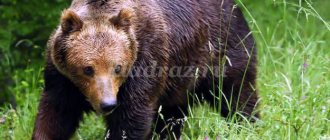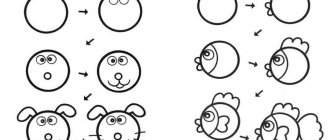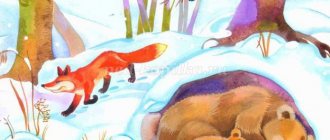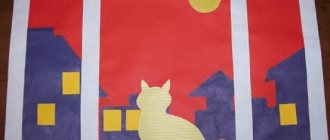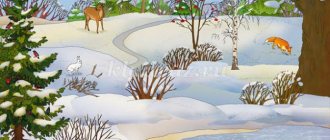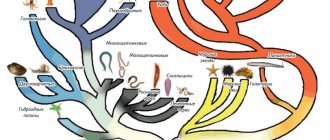LiveInternetLiveInternet
Quote from Tatyana57
Read in full In your quotation book or community!
SPEECH DEVELOPMENT. LEXICAL TOPIC “WILD BEASTS OF OUR FORESTS AND THEIR CHILDREN”
CHILDREN SHOULD KNOW THE NOUNS: bear, she-bear, bear cub, wolf, she-wolf, cub, hare, hare, little hare, fox, fox, fox, fox, hole, lair, squirrel, squirrel, hollow, moose, elk, calf, horns, hedgehog , hedgehog, hedgehog, wild boar, female boar, boar, badger, badger, little badger, forest, clearing, cheat, paw, wool, claws, nose, ears, hooves, tail. Muzzle, snout, mouth, animals, cubs, bushes, trees, mouse, lynx, raccoon, beaver, deer, marten, fangs, sable, mink, mole, den, connecting rod. ADJECTIVES: brown, clubfooted, cunning, predatory, gray, tireless, scary, thick (fur), red, wild, fluffy, dexterous, careful, fast, white, cowardly, long-eared, lop-eared, sensitive (ears), oblique, timid, velvet, prickly, wolf, striped. VERBS: wanders, climbs, roars, tears (bast), jumps, gallops, growls, grins. Hunts, escapes, howls, gnaws, digs, runs, “gave a go,” collects, stores, grunts, sniffs, sniffs, listens, hides, pricks, sneaks, sucks, lies down, falls. CHILDREN SHOULD BE ABLE TO NAME THE FAMILY: Bear, she-bear, little bear. Hare, hare, little bunny... SELECT NOUNS TO ADJECTIVES: Brown, club-footed, clumsy -... Gray, toothy, scary -... Cunning, fluffy, red-haired -... CALL MOM: The bear's cub, the fox's cub..., the bunny's... WHO HAS A VOICE : The fox yelps, the bear growls, the wolf howls... WHO LIVES WHERE: A fox lives in a hole. In the den - ... In the den - ... In the hollow - ... TO WHOM WE WILL GIVE WHAT: Meat - to the wolf, raspberries - ..., honey - ..., carrots - ..., nuts - ... SELECT NOUNS TO THE VERB: Hunts - ... Sneaks - ... Howls - ... Bites - ... Jumps - ... Tricks - ... Waddles - ... SELECT SIGNS: Wolf (which one?) -.... Fox (what?) - ... Hedgehog (what?) - ... SELECT ACTIONS: Bear (what is he doing?) - ... Fox (what is he doing?) - ... Hare (what is he doing?) - ... CORRECTLY ANSWERING THE QUESTIONS: Whose? WHOSE? WHOSE? WHOSE? Track - wolf, fox, hare... Ears - bear, hare, squirrel... Head - elk, hedgehog, wolf, fox... FORM NEW WORDS USING PRESIDENTS: Walks - moves, leaves, goes around, passes, enters, enters, descends, finds , leaves, approaches, reaches, comes, leaves, passes. COMPLETE A DESCRIPTIVE STORY ACCORDING TO PLAN. What is the name of? Where does he live? What kind of home does he have? What is the appearance? What habits? What does it eat? How does it get food? What are his enemies? How to defend yourself? What is the cub's name?
The fox is a predator. The fox mainly hunts mice, gophers, and less often hares. The fox cunningly catches hedgehogs. She rolls the hedgehog to the water, he straightens his spines in the water and swims to the shore. This is where the fox is waiting for him. The fox lives in a hole, and in the spring the fox gives birth to cubs. The squirrel is a rodent. She eats nuts, berries, mushrooms, and pine cones. The squirrel has sharp claws. This helps her quickly climb the tree. The fluffy tail serves as a parachute for the squirrel. A squirrel lives in a hollow and insulates its nest with down. In summer the squirrel is red, and in winter it is gray. In winter, the squirrel sleeps almost all the time and rarely looks out of the hollow. The squirrel is a thrifty housewife. She prepares nuts for the winter and dries mushrooms on tree branches. In the spring, squirrels give birth to squirrels. The wolf is a predatory animal. Wolves live in a pack. A pack is a wolf family. Wolves almost always hunt for sick, weak animals. Wolves hunt at night. Wolves live in a den to raise wolf cubs; wolf cubs appear in the spring. The bear is an omnivore. He loves to eat honey, berries, fish, ants, roots, but can also attack humans. The bear is clumsy in appearance, but easily climbs trees and runs quickly. The bear builds a den for himself from twigs, fallen trees, and moss. In winter, a mother bear gives birth to cubs. If a bear has accumulated little fat since the fall, it wakes up in the winter and walks through the forest hungry. For this the bear was nicknamed the connecting rod. The hare is a rodent. The hare feeds on grass, leaves, shrub bark, mushrooms, and roots. In winter, it chews the bark of trees. The hare is white in winter and gray in summer. This helps him hide from predators. Long, fast legs also save the hare from its enemies. The hare runs up the mountain at a run, and down the mountain somersaults. The hare lives under a bush in the summer, and digs a hole in the snow in the winter. In the spring, the hare gives birth to baby hares.
EXERCISE “GUESS AND TELL”. This beast lives in the forest, gnaws the bark of the trunks. In the summer in a gray fur coat, and in the winter in a white one. (Hare) - What does the hare eat in the spring? (grass, leaves). The owner of the forest wakes up in the spring, and in winter, to the howl of a blizzard, he sleeps in a snowy hut. (Bear) -What does a bear eat? (roots, grass, beetles, mice, hares). You and I recognize the animal by these two signs: He wears a gray fur coat in the winter, and a red fur coat in the summer. (Squirrel) - What does a squirrel feed on? (cones, nuts). All winter between the Christmas trees I slept through a bag of needles. “F-f-f-f—stop sleeping, It’s time to get up!” (Hedgehog) - What does a hedgehog eat? (bugs, worms, mice). Gray and toothy. Howls on a rainy day: “Uh-uh...” (Wolf) - What food does a wolf eat? (meat - catches mice, hares, sheep). Fluffy tail, golden fur, lives in the forest, steals chickens in the village. (Fox) - Who else does the fox catch? (mice, hares).
Desert Animals
Camel
Camels live in desert and semi-desert. They don't build housing. They feed on grass (both dry and fresh), tree branches, camel thorn, ephedra, wormwood, and chew saxaul branches. A camel accumulates nutrients in its humps, so it can go without food for a long time.
fennec
Fenech lives in deserts and semi-deserts. He digs himself a hole in the sand. Fennec fox is omnivorous. It feeds on insects, lizards, bird eggs, small rodents, and plant roots that can be dug up in the desert.
When the child has become acquainted with animals, their way of life, and nutrition, let him try to tell himself about what he remembers. Pictures and diagrams with an algorithm for composing a descriptive story will help with this >>
At first, you may not be able to get a coherent story, then try printing and cutting the cards above into sectors, and ask your child to arrange the pictures correctly.
More detailed stories for children about animals can be found on our website in the sections:
We enrich and activate our vocabulary. We consolidate knowledge of nouns:
squirrel, hollow, fox, hole, hedgehog, hare, wolf, lair, elk, bear, den, lynx, forest, deer, horns, hooves, body, fangs, wool, fur, needles, skin, mouth, paws, belly, claws;
verbs:
extract, jump, scour, howl, growl, squeak, roar, hunt, hide, yelp, snort, teach, guard, suck, loop, feast;
adjectives:
large, small, shaggy, shaggy, fluffy, strong, cunning, prickly, fast, dexterous, brown, toothy, clumsy, clumsy, beautiful, sharp, striped, powerful, flexible, clumsy, cautious, predatory;
adverbs:
quickly, deftly, slowly, dangerously, scary.
We teach a child to write riddles and descriptions about wild animals
. The first words in the riddle must be the words: this is an animal. The next words may be to clarify the size of the animal (large, small, small, etc.). Then you need to talk about the characteristic features of appearance (fluffy, shaggy, prickly, clumsy) and what the animal eats.
Wild animals of the forest
Hare
The hare lives in the forest. He does not dig holes for himself, but hides in bushes, in recesses under roots, under branches, where he builds a winter hut for himself. The hare's main food is grass, hay, and young tree branches. The hare also eats vegetables, fruits and berries, if he can find them.
Fox
The fox is a wild animal. She lives in the forest, in a hole. The fox is a predatory animal. The main food of foxes is insects (beetles, earthworms) and small rodents (voles). If the fox manages to catch a hare or a bird, which does not happen very often, she will happily eat them too. Often foxes settle next to humans and steal poultry from poultry houses. Sometimes she can also feast on fish washed up on the shore. She will not disdain berries and fruits when she is hungry.
Wolf
The wolf is an animal of the forest. Wolves live in a den. Wolves hunt in packs, so they are able to catch large prey: elk, deer. The wolf will gladly treat himself to both the bird and the bunny. In hungry years, wolves can attack livestock, but this happens very rarely. Wolves are very cautious and afraid of humans.
Hedgehog
Hedgehogs live in the forest. They rarely dig holes themselves, more often they occupy someone else’s or build a nest among protruding roots, under a bush, in depressions in the ground, dragging there a lot of leaves, dry grass and moss. In winter, hedgehogs hibernate. Hedgehogs eat mainly insects. If they come across a snake, they might eat it too. Don't mind eating mushrooms, acorns, berries and fruits.
Brown bear
The brown bear is a wild animal of the forest. For the winter, the bear builds a den for itself and hibernates. The main food of bears is berries, roots, and mushrooms. If a bear finds a bird's nest, it will feast on eggs; if it finds a hive of wild bees, it will eat honey. The bear knows how to catch fish and eats it with pleasure. He can even eat a mouse if he manages to catch it. He will not disdain carrion either.
Squirrel
A squirrel lives in the forest. She finds a hollow in a tree and settles there. The squirrel eats berries, fruits, mushrooms, nuts, acorns and grains. Stores supplies for the winter, hiding them under roots or among tree branches so as not to starve in winter.
On the topic: methodological developments, presentations and notes
Presentation on direct educational activities on speech development in the senior group. Domestic and wild animals
Presentation on direct educational activities on speech development in the senior group. Domestic and wild animals...
"Domestic and wild animals"
Summary of the final event on the topic “Domestic and wild animals” (for children of the middle group using ICT) Purpose: to summarize children’s knowledge about domestic and wild animals, their characteristics. Objectives: -…
Domestic and wild animals"
Goal: to consolidate children’s knowledge about wild and domestic animals, to continue to teach them to classify according to their habitat. Name the actions they perform. Learn to name orally, use phrases...
Approximate plan - summary of GCD on cognitive development Topic: “Journey to the animal world (domestic and wild animals and their young)
An approximate plan - summary - of educational activities on cognitive development Topic: “Journey to the world of animals (domestic and wild animals and their young)1...
Game tasks on the lexical topic “Wild Animals”
Author-compiler:
Deputy Head of Educational and Methodological Work Olga Yuryevna Bazhenova
These homework assignments are intended for children 5-7 years old. Based on the practical material of each lexical topic, the child accumulates and enriches his vocabulary, develops coherent speech skills and improves mental processes (attention, memory, thinking). There is also a gradual overcoming of violations of the grammatical structure of speech.
1.
Look at the pictures with your child. Introduce him to the names of wild animals. Fix the generalizing concept of “wild animals” in the dictionary.
2.
Show the animal body parts (torso, head, tail, horns, hooves, etc.). Remember their names.
3.Exercise "Guess"
: Complete the sentence:
Legs, hooves, horns
- from ... (moose).
Tassels on the ears
- on ... (squirrels, lynxes).
The needles on the body
are from ... (hedgehog).
4.
Tell your child about what the wild animals of our forests eat and where they live (in a hole, den, lair, hollow, etc.)
5.Exercise “Select, name, remember”
: Complete the sentences (pick up and name as many words as possible - signs, words - actions):
Bear
(which one?)
–
brown, huge, shaggy, clumsy, club-footed, strong. Hare (what?)
- ...
Fox (what?)
- ...
Bear (what is he doing?)
- waddles, roars, sleeps ...
Fox (what is he doing?)
- ...
Hare (what is he doing?)
- ...
6.Exercise “Say the opposite”
: Finish the sentence.
The elk is big, and the hare
...
The wolf has a long tail, and the bear
...
The squirrel is weak, and the wolf
....
7.
The cold weather set in, the animals got sick and reached out to Dr. Aibolit.
In the morning, the doctor noticed that many animals had gathered in the clearing near the hospital. Exercise “Who is with whom?”
: Look at the picture. Who came to Doctor Aibolit's clinic? (Fox with a fox cub. Hare with a little hare. Etc.)
8.Exercise “Call me kindly”...
Children need to know.
Nouns:
cat, cat, kitten, dog, dog, puppy, cow, bull, calf, horse, horse, foal, pig, hog, piglet, goat, goat, kid, sheep, ram, lamb, rabbit, bunny, bunny, herd, herd, pigsty, shepherd, milkmaid, pig farm, horns, hooves, tail, mane, fur - wool, stubble, bone, paws, farm, collective farm, udder, nostrils, stable, can, collective farmer (tsa), oats, swill, hay , muzzle, head, mouth, claws, hooves, ears, jaw, leather, saddle, bridle, whip, cart, kennel, pasture, rabbitry, groom, bangs, snout, nickle, animals
Adjectives:
short, long, soft, fluffy, gray, red, smooth, shaggy, hard, thick, curly, domestic, smooth-haired, watchdog, sanitary, border, fire, circus, affectionate, kind, mustachioed, clumsy, strong, fast, weak, long-eared, loyal, funny, amusing, spotted.
Verbs:
meows, moos, barks, grunts, neighs, chews, bleats, gnaws, purrs, laps, grazes, eats, digs, harnesses, gnaws, kicks, runs, butts, feed, groom, jumps, carries, gives milk, catches, guards , guards, prances, jumps, licks, tugs, plays, makes friends.
Children should be able to.
Find cubs and their parents and vice versa.
The cat has a kitten, the dog has a puppy, the goat has a kid...
Select signs.
Puppy - small, long-eared, funny, stupid, funny... Calf - ..., Cat - ..., Rabbit - ...
Describe animals according to plan.
Name. Appearance. What does it eat? Where he lives. How he gives his voice. What benefits does it bring?
Compare two animals according to plan.
What body? What is it covered with? What ears, nose, eyes, tail, muzzle...? What do they eat? Where live?
Together with the child.
Give each other descriptive riddles.
Jumps, chews, hides. Who is this? Butting, chewing, bleating. Sneaks, scratches, purrs. Grazing, chewing, mooing. Gnawing, guarding, barking.
Observe any pet.
Discuss the external signs of each by answering the questions:
- why can’t you hear the cat walking?
- why does a horse have horseshoes on its feet?
- why does a cow have horns, etc.
